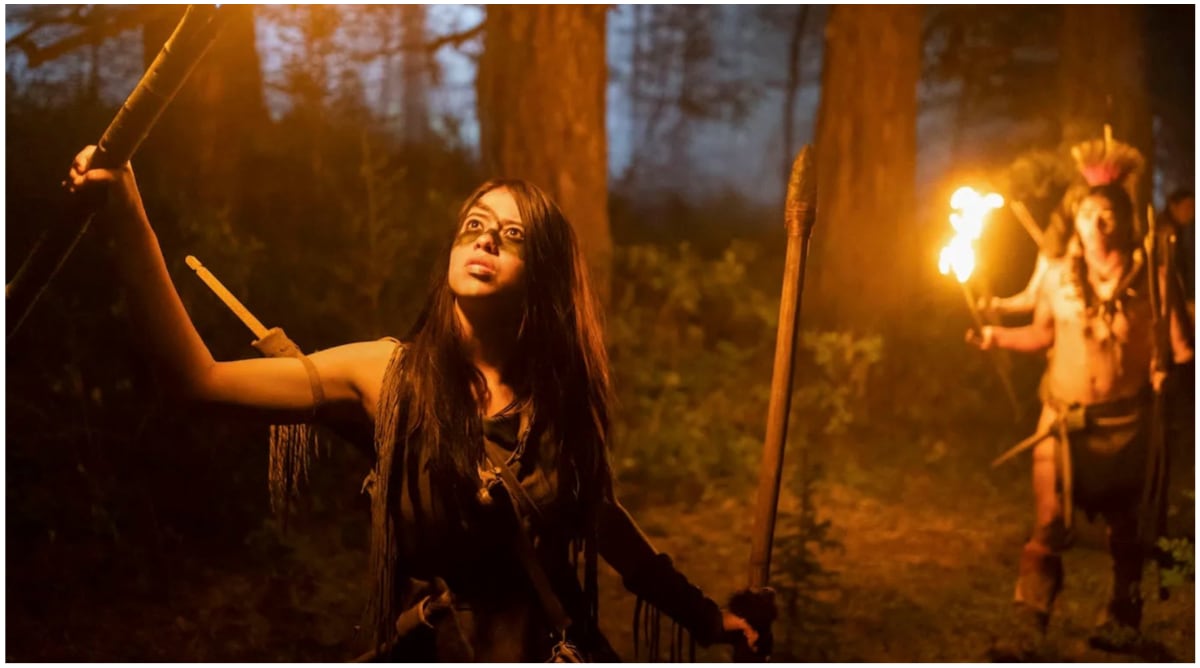 Amber Midthunder in a still from Prey. (Photo: Hulu)
Amber Midthunder in a still from Prey. (Photo: Hulu)A survival thriller in more ways than one, Prey brings a female perspective to a famously masculine franchise. Stylistically, tonally, and thematically, it couldn’t be more different from the last entry in the Predator series, a testosterone-fuelled action film directed by Shane Black. Released in 2018, The Predator underperformed at the box office and attracted criticism for — among other things — its (problematic) portrayal of autism. Every minute of Prey feels like an act of rebellion against that film, and in a larger sense, against Hollywood reboot culture in general.
A slap in the face of the ‘go big or go home’ school of thought, the film does for the Predator franchise what Todd Phillips’ Joker did for the Batman movies. As the title suggests, Prey actively flips the narrative on its head. Instead of being the bloated, CGI-fuelled slugfest that we’ve come to expect of sequels, it’s is a lean, character-driven drama. It’s action-packed, but unafraid of silences; it’s woke, but without pandering to minorities. It’s no coincidence then that in the role which would normally be reserved for an Arnold Schwarzenegger type, Prey has slotted a young woman.
Set in the Comanche Nation during the early 1700s, Prey tells the story of Naru, a warrior who discovers that her tribe might be under threat from a mysterious hunter far more formidable than the grizzlies and cougars that they usually encounter. Amber Midthunder stars as the young Naru, who struggles to fit in with her brother and his cocky friends in the dog-eat-dog world that they inhabit. And when they refuse to believe her when she tells them that she’s actually seen the predator on a rampage, she goes on personal a mission to prove to her bullies (but mostly to herself) that she isn’t worthless. That she must be believed.
Midthunder is revelation. She carries the film almost entirely on her shoulders, and is skilled not only in the action sequences — there’s a lot of axe-throwing, skulking around, and hand-to-hand fighting — but also in the many dramatic detours that the story takes. Her relationship with her (over) protective brother, and her canine companion, is particularly memorable. Naru is strong-willed, yet vulnerable; formidable but not infallible. But what makes her so compelling as a character is her lack of self-confidence; I’d imagine many viewers, not just young women, would relate.
Subscriber Only Stories
Director Dan Trachtenberg, who after helming the delightful 10 Cloverfield Lane — another film that completely upended franchise expectations — found himself attached to project after project that didn’t take off for various reasons. He reasserted himself on television, with the excellent pilot episode of The Boys, and Playtest on Black Mirror. Trachtenberg was revealed as the director of Prey after hushed whispers about the film first began doing the rounds some months ago. It was going to be a prequel, they said, and if you prodded further, you’d hear a tantalising half-truth about the film being in a foreign language.
This isn’t entirely accurate, although Trachtenberg — like some of our own filmmakers — has filmed Prey like a bilingual movie. In addition to the English version, there’s apparently going to be a version entirely in the Comanche language, which is a first, and should be celebrated. But even though the film is dedicated to the Comanche Nation, I’m still not sold on the subtext here. Is it exploitative to set a movie that directly deals with the evisceration of humans at the hands of alien invaders within a community that suffered similar persecution, but in real life?
Naru encounters villainous white settlers in the film’s third act, which suddenly roots the story in a recognisable reality after an hour or so of mostly fantastical world-building. But Trachtenberg handles both elements of the story with a deftness of touch. Prey is both a solid genre picture with a series of imaginatively filmed kill sequences and an inward-looking drama about a young person trying to find her place in the world.
Notice how Trachtenberg holds the camera on his heroine as she walks in and out of her village, and across the vast landscapes around it; he doesn’t turn away from moments of perceived inaction, and understands the importance of tone and atmosphere. Marvel has made mainstream Hollywood filmmakers positively terrified of silences; their movies will invariably insert a quip to offset onscreen discomfort, almost as a defence mechanism. And while this is an okay strategy sometimes, it’s scary when this becomes the default setting, and scarier when it begins to inform moviemaking at large. Shane Black, for instance, appeared to have been expressly instructed to mould his Predator movie into a wise-cracking Marvel adventure targeted at teen boys.
But Prey is like The Revenant meets Apocalypto. Doesn’t that sound brilliant? It’s a pity then that the film has been offloaded to streaming, because this is the kind of big-screen entertainment that we’re starving for.
Prey
Director – Dan Trachtenberg
Cast – Amber Midthunuder, Dakota Beavers, Diego DiLiegro
Rating – 4/5
- The Indian Express website has been rated GREEN for its credibility and trustworthiness by Newsguard, a global service that rates news sources for their journalistic standards.

